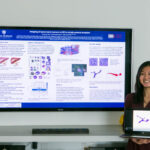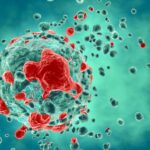Engineers put a new ‘twist’ on lab-on-a-chip
A leaf works something like a miniature laboratory. While the pores on the leaf surface allow it to channel nutrients in and waste products away from a plant, part of a leaf’s function also lies in its ability to curl and twist. Engineers use polymers to create their own mini-labs, devices called “labs-on-a-chip,” which have numerous applications in science, engineering and medicine. The typical flat, lab on a chip, or microfluidic device, resembles an etched microscopy cover slip with channels and grooves.
But what if you could get that flat lab-on-a-chip to self-assemble into a curve, mimicking the curl, twist or spiral of a leaf? Mustapha Jamal, a PhD student and IGERT fellow from Johns Hopkins Institute for NanoBioTechnology, has created a way to make that so.
Jamal is the lead author on “Differentially photo-crosslinked polymers enable self-assembling microfluidics,” published November 8, 2011 in Nature Communications. Along with principle investigator David Gracias, associate professor of Chemical and Biomolecular Engineering in the Whiting School of Engineering, and fellow graduate student Aasiyeh Zarafshar, Jamal has developed, for the first time, a method for creating three-dimensional lab-on-a-chip devices that can curl and twist.
The process involves shining ultraviolet (UV) light on a film of a substance called SU-8. Film areas closer to the light source become more heavily crosslinked than layers beneath, which on solvent conditioning creates a stress gradient.
Immersing the film in water causes the film to curl. Immersion in organic solvents like acetone causes the film to flatten. The curling and flattening can be reversed. The result, Jamal said, is the “self-assembly of intricate 3D devices that contain microfluidic channels.” This simple method, he added, can “program 2D polymeric (SU-8) films such that they spontaneously and reversibly curve into intricate 3D geometries including cylinders, cubes and corrugated sheets.”
Members of the Gracias lab have previously created curving and folding polymeric films consisting of two different materials. This new method achieves a stress gradient along the thickness of a single substance. “This provides considerable flexibility in the type and extent of curvature that can be created by varying the intensity and direction of exposure to UV light,” Gracias said.
Gracias explained that the method works with current protocols and materials for fabricating flat microfluidic devices. For example, one can design a 2D film with one type of lab-on-a-chip network, and then use their method to shape it into another geometry, also with microfluidic properties.
“Since our approach is compatible with planar lithography methods, we can also incorporate optical elements such as split ring resonators that have unique optical features. Alternatively, flexible electronic circuits could be incorporated and channels could be used to transport cooling fluids” Gracias said.
Tissue engineering is among the many important applications for 3D microfluidic devices, Gracias said. “Since many hydrogels can be photopolymerized, we can use the methodology of differential cross-linking to create stress gradients in these materials,” Gracias explained. “We plan to create biodegradable, vascularized tissue scaffolds using this approach.”
Link to the journal article here.
Story by Mary Spiro
Latest Posts
-
 Q&A with PSON Intern Jocelyn Hsu
August 19, 2021
Q&A with PSON Intern Jocelyn Hsu
August 19, 2021
-
 Start Up Founders from Johns Hopkins Aim to Stop Spread of Cancer
August 3, 2021
Start Up Founders from Johns Hopkins Aim to Stop Spread of Cancer
August 3, 2021
-
 Protein Appears to Prevent Tumor Cells from Spreading Via Blood Vessels
July 15, 2021
Protein Appears to Prevent Tumor Cells from Spreading Via Blood Vessels
July 15, 2021


